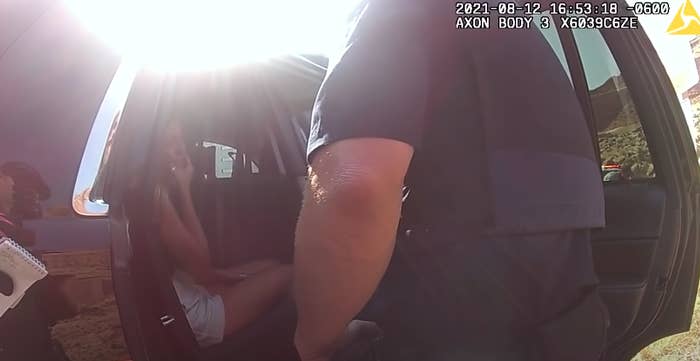
Like many true crime fans, Kayla Walters closely followed Gabby Petito’s disappearance, tracking new developments as well as social media theories about what happened to the 22-year-old aspiring #VanLife influencer.
But when police in Moab, Utah, released body camera footage showing Petito describing an altercation with her fiancé nearly one month before she went missing, Walters, a survivor of domestic violence, felt she knew what happened: The way Petito held her own face to demonstrate how Brian Laundrie had grabbed her during a fight was an immediate, familiar warning sign. As she watched the video, Walters was sure that Petito had been at risk of strangulation, and with it, death.
“If he could do that, he could go further,” said Walters, a 35-year-old Kentucky resident who told BuzzFeed News she survived being strangled by her then-husband in 2020. “A lot of survivors thought the same thing ... Just by her saying, ‘He grabbed my face’ ... A lot of people that have been through it saw that as a big red flag.”
Though Laundrie had not been charged in Petito’s death, so far, Walters and her fellow survivors had been right. On Oct. 12, the Teton County coroner announced Petito died by strangulation.
Nearly all of the five strangulation survivors BuzzFeed News spoke with think Petito could have been saved if the officers who spoke with her in August had known how to detect whether someone is at risk. (The Moab City Police Department did not respond to questions from BuzzFeed News.) The survivors see themselves in her case, and they want better outcomes for other people who are experiencing domestic violence. Now they’re speaking out on social media about how a lack of awareness about strangulation and the difficulties in reporting it have left gaps in prevention and intervention.
“Everybody knew before the [coroner’s] report came out how she died,” Kit Hunt, 52, a strangulation survivor in Austin, told BuzzFeed News. “We need to talk about how common this is ... How survivors are treated ... We’re not believed ... We focus on the crime, and then everybody forgets about it. We need more discussion, that’s what’s missing.”
Tw:DV Being a survivor of DV and strangulation, I know the fear #gabbypetito must have felt. Trying to breathe, clawing at your attackers face, kicking, doing anything to get that precious breath of air. I was lucky to survive my attack. Most aren’t. Please do you
Strangulation is often a precursor to homicide by intimate partners. People whose partners have attempted to choke or strangle them in the past are nearly 10 times more likely to be murdered than others, according to research published by the National Institute of Justice.
“Men who strangle women are the most dangerous men on the planet,” Casey Gwinn, president of the advocacy group the Training Institute on Strangulation Prevention, said in an email to BuzzFeed News. “Women are not strangled for the first time when they are murdered. They are always strangled multiple times before they are killed.”
In cases that are not fatal but in which the abuse is long-term, repeated burst blood vessels and lack of oxygen to the brain may cause blood clots, stroke, and other traumatic brain injuries, according to Kathryn Laughon, an associate professor of nursing at the University of Virginia who studies the effects of strangulation.
And though strangulation is one of the most dangerous forms of domestic violence, the warning signs can be difficult to detect and easy to minimize. According to experts, they include:
- Any intimate partner nonconsensually putting their hands around someone’s throat or face, or otherwise blocking a person’s arteries
- A partner tying a scarf, tie, belt, rope, or other object around the neck without consent
- A partner exhibiting a capacity for jealousy or control, such as tracking their partner's location, lashing out if they don’t receive an immediate response to a text message, or separating the victim from their friends and family
Women of color are particularly at risk, according to a 2007 study that found Black women were more likely than other groups to have experienced this specific kind of violence. Other data shows 37% of Indigenous women who experienced intimate partner violence were strangled. Experts hope Petito's death draws attention to the bigger issue.
“She’s one of many,” Laughon said. “There’s a lot of Black and Indigenous women who are experiencing the same thing and aren’t getting the same media attention.”
For people who have survived strangulation, the nonstop coverage of Petito’s case has resurfaced difficult memories of their own experiences.
Hunt said she could “hardly function” after the news, so, like other survivors, she turned to Twitter, Facebook groups, and YouTube. She processed her trauma surrounding Petito via online forums for survivors, which she said have become increasingly populated and active about Petito’s death. In these groups, which are usually private, survivors share personal stories, resources, and — most importantly, Hunt said — “red flags” to look for.
“We talked about it almost every day,” she said.
Stephanie Harris, an attorney in Oak Park, Illinois, noticed survivors sharing their stories on social media and started a Facebook group to offer them resources and answer legal questions. Her private Justice for Gabby group has 135 members, many of whom have experienced abuse from romantic partners.
“There are a lot of women who have had bad experiences and have used this forum as an opportunity to hear what’s happening in a place that feels like a safe place and process the news,” she told BuzzFeed News.
Walters has worked through the news via Twitter DMs with a group of five fellow survivors, women whom she now regularly checks in with. She said she wishes she could hug them and tell them she’s happy they’re alive.
Brianna, a 23-year-old living in California who, to protect her privacy, asked her full name not be used, said she was strangled in 2017, but she has only started talking about it this year. Petito’s story “sparked something” in her, she said, and she’s felt encouraged to be open about what happened to her, knowing she’s not alone.

“When the news came out of her strangulation, it was like a deep pit in my stomach, which turned to rage,” Brianna said.
“I was shocked and not shocked,” said Meredith, 28, another survivor living in Oregon who asked her full name not be used. Meredith told BuzzFeed News that after seeing the footage of Petito holding her jaw where she told officers Laundrie had grabbed her, she feared he had done it before and would do it again.
“He was ramping up,” she said.
Meredith said she left her abusive relationship eight years ago and went on to be happily married. But the fear of strangulation still regularly resurfaces — when her son touches her neck, or when she’s watching a movie. She added it’s tragic that it’s taken Petito’s death to start a conversation about the prevalence of strangulation, which she described as an “open secret.”
“If we’re honest, we all know someone who's gone through it,” she said.
But people who have experienced it often hesitate to report strangulation, either out of a desire to protect their abuser or because of distrust of law enforcement.
Dana, a 36-year-old living in Chicago, told BuzzFeed News she never felt safe calling the police, even after she was strangled, so she reached out to a domestic violence hotline instead. But when they referred her to law enforcement, she never reported it.
“I was not willing to have my boyfriend arrested,” she said. “So I decided to let it go.”
The physical indications of strangulation can be more difficult to detect than those of other types of assault, making it hard for victims to point to their abuse when reporting it, or for prosecutors to have viable evidence to bring charges, Laughon said. Typical signs include a raspy voice, visible burst blood vessels, and difficulty breathing, but strangulation can also cause red eyeballs, bald spots, ear ringing, bruising, swollen lips, facial drooping, and chest pain.
“The signs are often much more subtle,” Laughon said.
Recognition of those signs, particularly by healthcare providers or law enforcement, can be a matter of life and death.
“We have been training on these issues for 25 years,” Gael Strack, CEO of the Training Institute on Strangulation Prevention, told BuzzFeed News. “Strangulation in domestic violence is a gendered crime. Men strangle women. Women virtually never strangle men. Police training on strangulation should be mandatory. When officers are well trained, we can prevent domestic violence homicides.”
Laughon added there’s also a need for more comprehensive research, which will improve prevention, detection, and treatment of the long-term physical and mental effects of strangulation. With so many victims afraid to report what happened to law enforcement or medical providers, researchers are missing large data sets to work with, particularly for communities of color.
“It’s horrifying we are still building the science around this to know exactly how to treat [strangulation],” Laughon said.
And despite the #MeToo movement and changes within US culture, the lack of research and resources available to survivors reveals limited progress when it comes to understanding abusive relationships and believing victims, Dana said.
“Abuse victims are still blamed for things that happen to them,” she said. “We are not at a place yet as a culture where we are ready to face these realities ... I hope that maybe Gabby’s story can lead to more research and prevention.”
